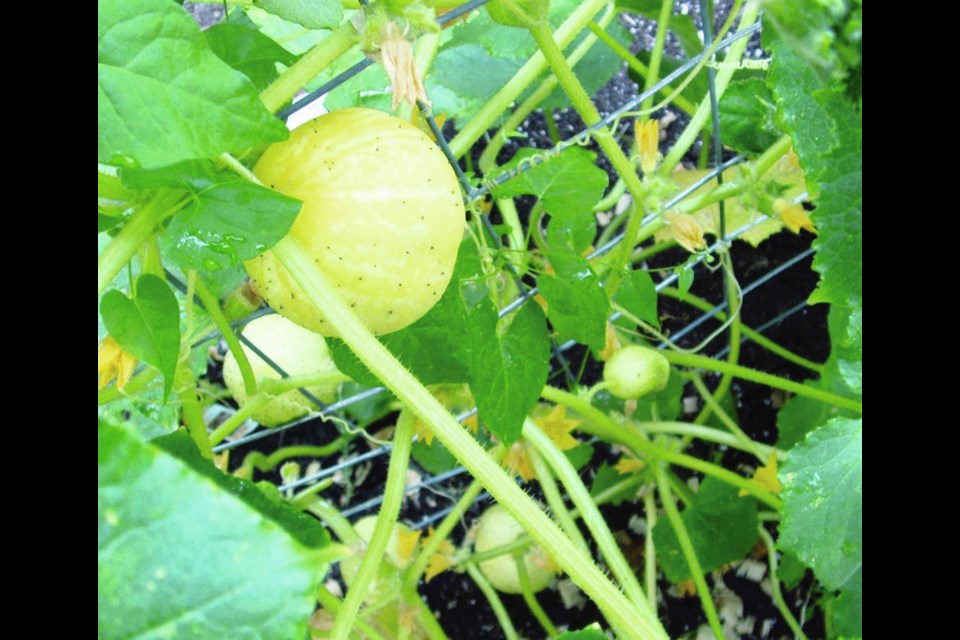It feels like a Mediterranean summer, probably because the garden’s abundance, and the heat, remind me of living on the south coast of France and on a Greek island. The foods I relished during those times abound in this summer’s garden — young zucchinis with the blossoms still attached, sweet onions and tomato, basil, juicy garlic, and squishy, super-sweet figs.
An explosion of cucumbers includes the miniature fruits of Green Light, the long slicer Sweet Success, and round, crunchy Lemon cucumbers, all yielding more prolifically than usual this summer.
Cucumber season coincides with the new garlic harvest, and the two combine in a refreshing dish I learned to make during a year living in a small Greek village, where I earned the little money I needed by tutoring a young British girl and typing for an American author who showed me how to make the dish.
Place plain yogurt (I use Greek yogurt) in a bowl. Add fresh lemon juice, a drizzle of olive oil, salt, and mashed garlic. Mix together and add chopped (not grated) cucumber. It’s delicious, cooling, and variable. I like it loaded with lemon juice and an immoderate amount of garlic.
The book and recipe exchange. My friend Vicky and I met recently for one of our book exchanges. We met on the back lawn, and sat to visit for a while. Because we both love good food, we also exchanged the various ways we were preparing our gardens’ vegetables.
Vicky described her latest way of preparing zucchini. Totally simple: Slice zucchini into an open baking dish. Top with garlic, a drizzle of oil and grated parmesan, and bake.
Never having met a recipe I didn’t want to tinker with, I placed halved cherry tomatoes and thin onion rings over the zucchini slices before drizzling the vegetables with oil and mashed garlic and topping with parmesan. A wonderful aroma emanated from the dish as it baked at around 350 F. Cooked tender, the mixture was a real Mediterranean style treat, like a baked ratatouille.
A new visitor. With gardening, every year brings something new to discover. An insect I’d never seen before in the garden caught my attention recently when I noticed it hovering around my potted sweet pepper plants. It wasn’t visiting the flowers. It was searching for something among the layers of foliage.
The insect looked like an ordinary yellowjacket wasp, but with a long, more elegantly slender body and a tiny waist. The wings and antennae had a light rusty-orange cast.
In consulting my bug books, I found tucked into the pages of one reference a two-year old Times-Colonist article on local wasps with a photo of the insect I’d just been observing. It’s a European paper wasp. Further research indicates that these wasps are good pollinating insects and they help to control pests as they feed mainly on caterpillars and other larvae.
I was oddly delighted to meet this attractive and useful insect as it foraged for food in my pepper plants.
Observations. The unusually long stretch of dry weather this year, together with temperatures higher than we are accustomed to, has caused more than a few disappointments, and a few surprises.
My figs began ripening several weeks earlier than usual, but other fruits and berries have not done so well. Some developing fruits suffered sunscald and some raspberries dried up in the intense heat.
The heat in some gardens caused tough snap peas, shelling peas less juicy and sweet than usual, and tomatoes that were mushy-textured and bland tasting.
When the heat wave in June arrived, I cut a few sweet peas for the house and was astonished to find them almost scentless. Later bouquets from the same plants, taken when the weather cooled, were beautifully fragrant.
Another surprise: Those sweet peas, a variety called Midnight in the Spencer Series (Johnny’s Selected Seeds), kept on churning out flowers, despite the heat and drought. Midnight produces showy clusters of deep rosy-burgundy flowers on long stems. Johnny’s also notes that its Mammoth Choice Mix withstands heat and drought well.
I’m presuming that future summers will bring more heat and drought. It’s time to observe and assess our garden plants and varieties for their ability to stay in healthy, productive condition in these challenging conditions, and look for varieties described as heat and drought resistant so that we can continue to enjoy productive gardens.



